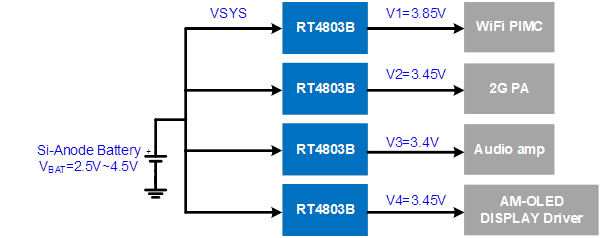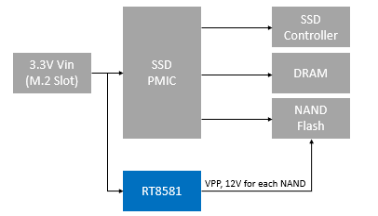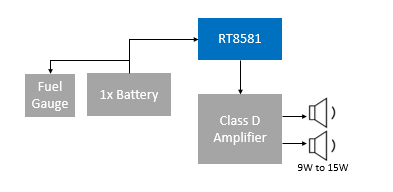Boost Converter Design Insights: Richtek's Popular Product Key Features and Design Examples
Kurt Lee, Sophia Tong | AN087
Richtek offers a diverse range of boost converter solutions to meet various application requirements. This application note explores the key features and application examples of popular boost converters, assisting engineers in selecting the most suitable product to ensure high efficiency and system stability.
1 Design Considerations for Selecting a Boost Converter
Selecting an appropriate boost converter requires evaluating multiple factors, including input and output voltage range, quiescent current, power capacity, control interface, packaging, and cost. Richtek's boost converter portfolio can be categorized into four major types based on functionality: Bypass Switch Integrated with I²C Control – RT4803/RT4803A/RT4803B Series, Low Quiescent Current – RT4823, Easy Design – RT4812 and High-Output Capability – RT8581.
|
|
With Bypass MOSFET
|
Easy Design
|
Low Iq
|
High Vout
|
|
|
RT4803
|
RT4803A
|
RT4803B
|
RT4812
|
RT4823
|
RT8581
|
|
Vin
|
1.8V-5.5V
|
1.8V-5V
|
1.8V-5V
|
1.8V-5V
|
1.8V-5.5V
|
2.7V-12V
|
|
Vout
|
2.85V-4.4V
|
2.85V-4.4V
|
2.85V-4.4V
|
1.8V-5.5V
|
5V
|
4.5V-12.6V
|
|
I/O
|
1.8V
|
1.8V
|
1.2V
|
1.8V
|
1.8V
|
1.2V
|
|
ISW
|
5A
|
4A
|
4A
|
4A
|
2.15A
|
10A
|
|
BYP_FET
|
Y
|
Y
|
Y
|
--
|
--
|
--
|
|
I2C
|
Y
|
Y
|
Y
|
--
|
--
|
--
|
|
Iq
|
65μA
|
55μA
|
56μA
|
90μA
|
4μA
|
30μA
|
|
Packages
|
RT4803?sc_lang=en" class="link">WL-CSP1.67x1.67-16(BSC)
|
RT4803?sc_lang=en" class="link">WL-CSP1.67x1.67-16(BSC)
|
RT4803?sc_lang=en" class="link">WL-CSP1.67x1.67-16(BSC)
|
TSOT-23-8(FC)
|
RT4803?sc_lang=en" class="link">WL-CSP1.3x1.2-9(BSC)
|
VQFN2x2.5-11
|
2 Application Examples of Different Boost Converters
2.1 Bypass Switch Integrated with I²C Control – RT4803/RT4803A/RT4803B Series
In a conventional boost converter operating in Bypass Mode, current flows from the input to the output through the inductor and high-side switch, resulting in higher conduction losses due to the resistance of the inductor. In contrast, the RT4803 series allows current to flow directly through the bypass switch to the output, bypassing the inductor, and eliminating DCR losses. This can effectively reduce conduction loss. This enhancement improves efficiency from the conventional 97 to 98% to nearly 100%, reducing power losses and minimizing heat dissipation.
The RT4803B, housed in a compact CSP package, supports I/O voltage as low as 1.2V, making it ideal for silicon anode batteries (Si-Anode battery) used in mobile modules such as 2G PA, WiFi modules, audio amplifiers, and other portable or wearable devices.

Figure 1. Mobile Power Application Example
2.2 Low Quiescent Current – RT4823
The RT4823, also in a CSP package, is designed for portable and wearable devices. For example, in On-The-Go (OTG) functionality, when a user connects peripherals like a small fan, storage device, or flashlight to the USB port, the mobile device must provide 5V output at 1.5A (7.5W) per the Type-C standard. The RT4823 meets this requirement while featuring only 4µA of quiescent current, making it ideal for long standby applications. Additionally, it features reverse blocking protection, preventing external voltage from flowing back to the input, enhancing system stability.

Figure 2. OTG Application Example
2.3 Easy Design – RT4812
The RT4812 is a high-efficiency boost converter housed in a TSOT-23-8 package. It offers a flexible output voltage adjustment via the FB pin and allows setting the output current limit to 1A or 2.1A through pin configuration. With a cost-effective TSOT-23-8 package that eliminates the requirements for PCB vias, the RT4812 is ideal for cost-sensitive applications on single or double-layer PCB boards, such as power bank, wireless mice and other consumer electronic devices.

Figure 3. Optical Mouse Application
2.4 High-Output Capability – RT8581
The RT8581 is a high-output-voltage boost converter that provides an efficient and compact power solution for systems with lithium-ion batteries, delivering up to 20W of power output. The RT8581 can deliver a stable output voltage from a single lithium-ion battery, with internal switching components featuring low on-resistance, achieving high efficiency of up to 94.5% (Vin = 5V, Vout = 12V, Iout = 1.5A). Figure 4 illustrates the application of the RT8581 in powering NAND Flash. By supplying VPP through the RT8581, the write speed of NAND Flash can be effectively improved, optimizing storage performance and enhancing overall system efficiency. In addition, the RT8581 can also power 9W to 15W audio amplifiers, as shown in Figure 5.

Figure 4. NAND Flash Power Supply Example

Figure 5. Audio Amplifier Application
3 Conclusion
Richtek offers a diverse range of boost converters to meet the requirements of various applications in terms of power efficiency, quiescent current, package size, and control interface. This application note provides an overview of the characteristics and application examples of different boost converters, assisting engineers in selecting the most suitable solution. The RT4803 series with a bypass switch reduces conduction losses and improves efficiency. The RT4823 with low quiescent current is ideal for OTG and long standby applications. The RT4812 offers a cost-efficient for easy designs, while the RT8581 provides high-output-capacity for applications like NAND Flash and audio amplifiers. These solutions enable engineers to achieve optimal power management with the best balance between high performance and low power consumption.
To stay informed with more information about our products, please subscribe to our newsletter.